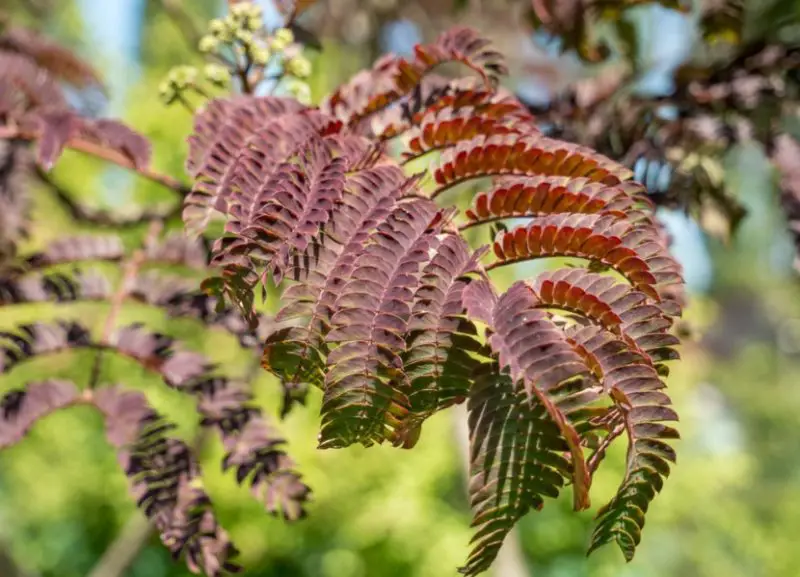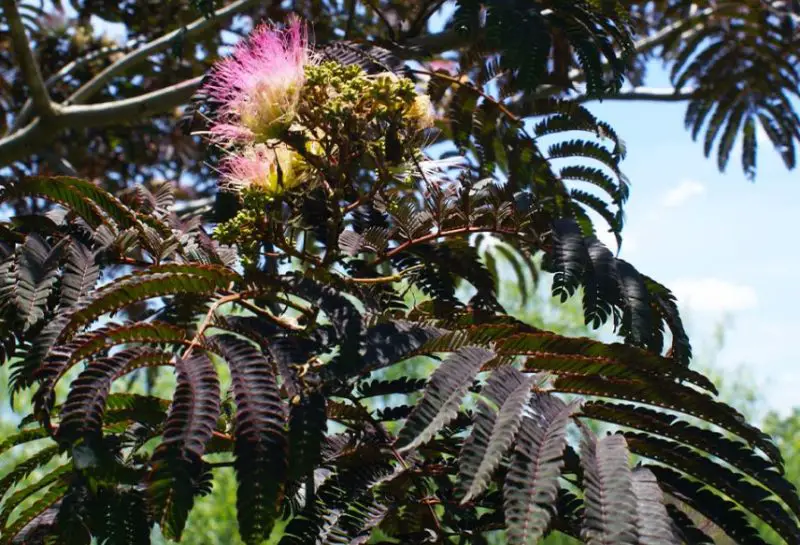If you have ever taken a trip through southern landscapes, it is likely that you have come across the well-known sight of mimosa trees. These trees provide an air of exotic attractiveness to any area they grow, with their tropical appearance made up of beautiful pink blossoms that grace the early summer scenery and slender leaves that resemble ferns.
However, if you want to add a touch of the tropics or some Asian flare to your garden, maybe it’s time to give the Chocolate Mimosa Tree (Albizia julibrissin ‘Summer Chocolate’) some thought.
About the Chocolate Mimosa Tree

The Chocolate Mimosa Tree, scientifically known as Albizia julibrissin ‘Summer Chocolate’, originates from Asia, where it thrives in warm climates. Its distinguishing feature lies in its umbrella-shaped canopy, adorned with slender, fern-like leaves. What truly sets it apart is its foliage, which transitions from vibrant green to dark red, and eventually to a reddish bronze or chocolaty brown hue by late summer. Its frothy pink blossoms in early summer add to its allure.
Recognizable by its tropical appearance and unique leaf coloration, the Chocolate Mimosa Tree offers a touch of exotic charm to any landscape, making it a sought-after addition for gardeners seeking botanical beauty.
Growing and caring for Chocolate Mimosa Trees

Growing a Chocolate Mimosa Tree can be a delightful addition to your garden, offering unique foliage, showy flowers, and minimal maintenance requirements. Here’s a guide to help you cultivate this exotic beauty:
Choose the Right Location
Choosing the right location for your Chocolate Mimosa Tree is crucial for its health and growth. Opt for a spot in your garden that receives ample sunlight, ideally full sun to partial shade. This ensures that the tree receives the necessary sunlight to thrive and produce vibrant foliage and blossoms.
Additionally, pay attention to the soil conditions. Chocolate Mimosa Trees prefer soil that is well-draining to prevent waterlogging, which can lead to root rot and other issues. Ensure the soil has good drainage by amending it with organic matter such as compost or peat moss if needed.
Moreover, consider the pH level of the soil. Chocolate Mimosa Trees thrive in slightly acidic to neutral soil pH. You can test the pH of your soil using a soil testing kit available at garden centers. If the soil pH is too high or too low, you can adjust it by adding amendments like sulfur or lime accordingly.
Planting
When it comes to planting your Chocolate Mimosa Tree, timing and technique are key to ensuring its successful establishment in your garden. Aim to plant your tree in either the spring or fall, when temperatures are moderate and rainfall is more consistent.
Begin by preparing the planting site. Dig a hole that is twice the width of the root ball and slightly shallower than its depth. This ensures ample room for the roots to spread out and establish themselves. Loosen the soil in the bottom of the hole to encourage root growth.
Next, carefully remove the tree from its container or burlap wrapping, taking care not to disturb the roots excessively. Place the tree in the center of the hole, making sure it is positioned at the same depth as it was in the container or wrapping.
Backfill the hole with soil, gently pressing it down to eliminate air pockets around the roots. Water the tree thoroughly immediately after planting to settle the soil and provide moisture to the roots.
Continue to monitor the soil moisture level in the weeks following planting, watering as needed to keep the soil evenly moist but not waterlogged. With proper planting and care, your Chocolate Mimosa Tree will soon take root and begin to thrive in its new home, gracing your garden with its beauty for years to come.
Watering
During the initial establishment period, proper watering is essential to helping your Chocolate Mimosa Tree thrive. Regular watering is necessary to ensure the soil remains evenly moist, providing the tree with the hydration it needs to develop a strong root system. However, it’s crucial to avoid overwatering, as waterlogged soil can lead to root rot and other issues.
Monitor the soil moisture regularly, especially during periods of hot weather or low rainfall. Water the tree deeply, allowing the water to penetrate the soil and reach the roots. Consider using a soaker hose or drip irrigation system to deliver water directly to the root zone and minimize water loss through evaporation.
As your Chocolate Mimosa Tree becomes established and its roots grow deeper into the soil, its water requirements will decrease. Once the tree is established, it becomes more drought-tolerant and requires minimal watering. During periods of extended dry weather, occasional deep watering may be necessary to keep the tree healthy and hydrated.
Fertilization
To ensure optimal growth and abundant flowering of your Chocolate Mimosa Tree, proper fertilization is key. In the spring, as the tree emerges from its winter dormancy, it’s an ideal time to apply a balanced fertilizer. This provides the tree with essential nutrients to support healthy growth and robust blooming throughout the growing season.
When fertilizing your Chocolate Mimosa Tree, it’s important to follow the manufacturer’s instructions for application rates carefully. Applying too much fertilizer can lead to nutrient imbalances or even damage to the tree. A balanced fertilizer, with equal proportions of nitrogen, phosphorus, and potassium, is recommended to provide the tree with a well-rounded nutrient boost.
Before applying fertilizer, water the tree thoroughly to ensure the soil is moist. Then, apply the fertilizer evenly around the base of the tree, avoiding direct contact with the trunk to prevent burning. Use a spreader or hand applicator to distribute the fertilizer evenly over the soil surface.
Once applied, water the tree again to help the fertilizer penetrate the soil and reach the roots. This encourages efficient nutrient uptake by the tree, promoting healthy growth and flowering.
Pruning
Pruning your Chocolate Mimosa Tree is a straightforward task that requires minimal effort, yet it plays a crucial role in maintaining its health and appearance. While Chocolate Mimosa Trees generally require minimal pruning, it’s essential to remove any dead or damaged branches to promote optimal growth and ensure a tidy appearance.
The best time to prune your Chocolate Mimosa Tree is in late winter or early spring, before new growth begins. During this time, the tree is dormant, making it easier to identify and remove any dead or damaged branches without causing undue stress.
Start by inspecting the tree carefully, identifying any branches that appear dead, diseased, or damaged. Dead branches are typically dry and brittle, with no signs of new growth. Diseased branches may show discoloration, oozing sap, or other symptoms of illness. Damaged branches may be broken or split, posing a risk to the tree’s overall health.
Using sharp and clean pruning shears, carefully remove the identified branches, making clean cuts just above the branch collar—the swollen area where the branch meets the trunk or main stem. Avoid leaving stubs or making rough cuts, as these can invite pests and diseases into the tree.
As you prune, step back occasionally to assess the tree’s overall shape and appearance. Aim to maintain a balanced and symmetrical canopy, removing any branches that disrupt the tree’s natural form or growth pattern.
Pest and Disease Control
Chocolate Mimosa Trees are known for their resilience to pests and diseases, making them a low-maintenance option for gardeners. However, it’s still essential to remain vigilant and conduct occasional inspections to ensure the tree’s health and vitality.
While Chocolate Mimosa Trees are generally resistant to pests, they may occasionally attract common garden nuisances such as aphids or spider mites. These pests can cause damage to the foliage if left unchecked. Therefore, regular monitoring is recommended to catch any infestations early.
If you notice signs of pest activity, such as distorted leaves, stippling, or webbing, prompt action is necessary to prevent further damage. Fortunately, controlling pests on Chocolate Mimosa Trees is relatively straightforward. Using natural remedies like insecticidal soap or neem oil can effectively eliminate pests without harming beneficial insects or the environment.
To treat pest infestations, simply apply the chosen remedy according to the manufacturer’s instructions, ensuring thorough coverage of the affected foliage. Repeat the application as needed until the pests are eradicated and the tree’s health is restored.
Winter Care
Winter care is crucial for ensuring the health and survival of young Chocolate Mimosa Trees, especially in colder climates where freezing temperatures pose a risk to tender plants. To protect your tree during the winter months, it’s essential to provide adequate insulation for both the roots and the above-ground portions.
Start by applying a layer of mulch around the base of the tree, extending out to the drip line. This mulch acts as a protective barrier, insulating the soil and roots from extreme temperature fluctuations and helping to retain moisture. Use organic materials such as wood chips, shredded bark, or compost for the mulch layer.
In addition to mulching, consider wrapping the trunk of the young tree with a protective material such as burlap or tree wrap. This helps prevent sunscald and frost cracks, which can occur when temperature fluctuations cause the bark to expand and contract rapidly.
For added protection, you can also erect a temporary windbreak or barrier around the tree to shield it from harsh winter winds. This can be achieved using stakes and burlap or fabric material.
Throughout the winter months, continue to monitor the tree’s moisture levels, ensuring the soil remains evenly moist but not waterlogged. Watering during dry periods can help prevent dehydration and stress, which can make the tree more susceptible to winter damage.
Enjoy the Beauty
Take a moment to bask in the sheer beauty that your Chocolate Mimosa Tree brings to your garden landscape. With its captivating foliage and extravagant display of showy flowers, this tree is a true gem that deserves to be admired.
As you sit back and relax in your garden, allow yourself to be mesmerized by the unique hues of the Chocolate Mimosa’s foliage, which add a touch of elegance and charm to any outdoor space. Watch as the sunlight dances through the leaves, casting dappled shadows and creating a tranquil atmosphere.
But the beauty of the Chocolate Mimosa doesn’t end there. Be sure to inhale deeply and savor the sweet fragrance that fills the air, emanating from its delicate blossoms. Close your eyes and let the scent transport you to a world of tranquility and serenity.
As you revel in the beauty of your Chocolate Mimosa Tree, take a moment to observe the pollinators it attracts, from buzzing bees to fluttering butterflies and graceful hummingbirds. These creatures are not only drawn to the tree’s beauty but also play a vital role in its reproduction, ensuring that its beauty continues to grace your garden for years to come.
So, embrace the beauty of your Chocolate Mimosa Tree and allow yourself to be fully immersed in the wonder of nature. Whether you’re enjoying a quiet moment alone or sharing the experience with loved ones, let the beauty of this magnificent tree uplift your spirits and fill your heart with joy.






